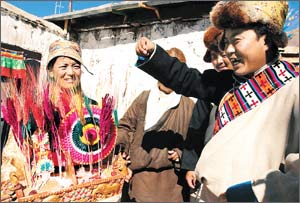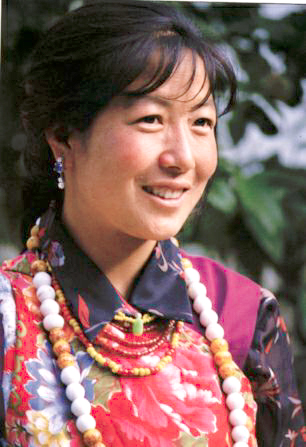| |
Of the many ethnic groups living in Tibet, the Tibetan, Naxi, Nu, Hui, Moinba, and Lhoba together with Deng and Sherpa groups have been inhabitants of Southwest China's Tibet Autonomous Region since ancient times. Among them, Tibetans are the dominant inhabitants, accounting for 92.2 percent of the whole regional population, and the last four groups (Moinba, Lhoba, Deng, and Sherpa) are the natives distributed only in Tibet -- no other places in China contain them.
Tibetans

Tibetans are the principal inhabitants of Tibet. Their language belongs to the Tibetan sub-group of the Tibetan-Burmese group of the Sino-Tibetan language family. There are three main dialects: U-Tsang, Kham, and Amdo. Most Tibetans work in agriculture and animal husbandry, while urban residents for the most part work in handicrafts, industry, and commerce. Ethnic Tibetans follow Tibetan Buddhism. They are enthusiastic and open-minded and good at singing and dancing. The Tibetan songs are pleasant to the ears and are often accompanied by dance.
Although different areas have different clothing, Tibetans traditionally wear long-sleeved silk or cloth jackets which men top with loose robes and women with long sleeveless gowns that are tied at the waist with a sash. Married women frequently wear an apron with a multicolor design. Both women and men braid their hair and love wearing ornaments.
The staple food is zanba (roasted qingke barley flour or pea meal), while tea with butter or milk is the favorite of all Tibetans. They have a liking for qingke barley wine, beef, and mutton, but do not eat horses.
In ancient times Tibetans buried their dead in the ground but in modern times Tibetans practice sky burial (in which the corpse is chopped to bits and exposed on a mountain face to be eaten by vultures and other birds of prey), cremation, and water burial.
Moinba

The Moinba people have lived on the Tibet Plateau since ancient times. For the most part they are distributed in the Moinyu region in the south, with some scattered in Medog, Nyingchi, and Cona counties. Linguistically, the Moinba belong to the Moinba sub-group of the Tibetan-Myanmar group of the Sino-Tibetan language family. In terms of dialects, the language is complex. While there is no written language, most Moinba people can speak and write Tibetan.
Their livelihood is based on agriculture, supplemented by animal husbandry, forestry, hunting, and handicrafts.
Both women and men dress in robes made of pulu (a woolen fabric). They also wear a small brown-crowned, orange-rimmed hat gaped in the front, or a black felt cap. The women wear bracelets and earrings and other ornaments and men have a chopper hanging at their waists.
Men and women alike enjoy drinking wine and dipping snuff. The Moinba diet is based on rice, corn, buckwheat and jizhuagu (glutinous highland millet). Men and women alike enjoy drinking wine and dipping snuff.
Most Moinba people adhere to Tibetan Buddhism; however, in some areas some people practice traditional shamanism. The dead are generally given water burial, but earth burial, sky burial, and cremation are also practiced.
|
|
